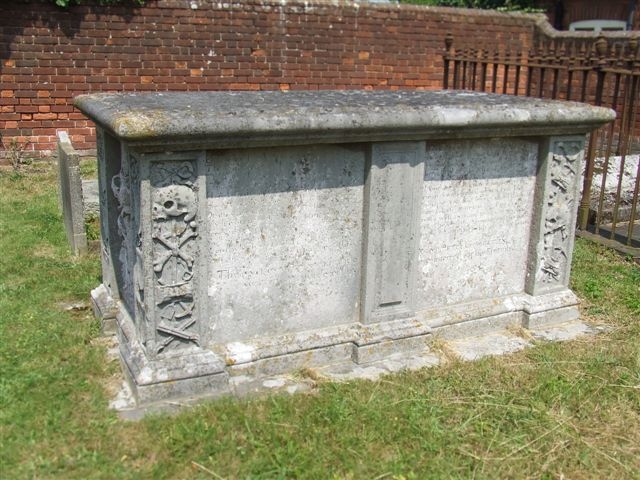In 1843 four pairs of forceps were discovered hidden beneath a trapdoor in an attic room of the Hall-it is likely these had been secreted there by Peter's widow. Also included were coins from the reign of King Charles II and a packet labelled "my husband's last tooth"
Peter's tomb was restored by the Royal College of Surgeons and the forceps are now in the museum of The Royal College of Obstetricians and Gynaecologists. The tomb is ornate but gruesomely decorated-on one side are details of his life and on the other are verses which he composed especially for this purpose. It stands between the church and the gate leading to his former home. Peter's surviving son, (by his second wife) Hope Chamberlen inherited the Hall and sold it about 1715.
In 1843 four pairs of forceps were discovered hidden beneath a trapdoor in an attic room of the Hall-it is likely these had been secreted there by Peter's widow. Also included were coins from the reign of King Charles II and a packet labelled "my husband's last tooth"
Peter's tomb was restored by the Royal College of Surgeons and the forceps are now in the museum of The Royal College of Obstetricians and Gynaecologists. The tomb is ornate but gruesomely decorated-on one side are details of his life and on the other are verses which he composed especially for this purpose. It stands between the church and the gate leading to his former home. Peter's surviving son, (by his second wife) Hope Chamberlen inherited the Hall and sold it about 1715.
Inscription
Here lyes ye body of Doctor Peter Chamberlen, who was born on the 8th of May, 1601, and died on the 22nd of December, 1683, being aged 82 years, 7 months, and 14 days. He had 2 wives, and by ye first, Jane Middleton, had 11 sons and 2 daughters, and amongst them 45 grandchildren and 8 great-grandchildren, whereof were living at his death 3 sons, viz., Hugh, Paul, and John, and his 2 daughters and 20 grandchildren, and 6 great-grandchildren. By ye second, Ann Harrison, he had 3 sons and 2 daughters, whereof only Hope was living at his death, who hath erected this monument in memory of his father.
The said Peter Chamberlen took ye degree of Doctor in Physick in severall universities, both at home and abroad, and lived such above three score years, being Physician in Ordinary to three kings and queens of England, viz, King James and Queen Anne, King Charles ye first and Queen Mary, King Charles ye Second and Queen Katherine, and also to some foreign princes, having travelled to most parts of Europe, and speaking most of the languages. As for his religion, was a Christian, keeping ye commandments of God and faith of Jesus, being baptized about ye year 1648, and keeping ye seventh day for ye Sabbath above 32 years.
To tell his learning and his life to men,
Enough is said by here lies Chamberlen.
Death my last sleep, to ease my careful head;
The grave my hardest, but my easiest bed.
The end of sorrow, labour, and of care;
The end of trouble, sickness, and of feare.
Here I shall sin no more; no more shall weep;
Here's only to be found a quiet sleep.
Death's but our night; my life hath many seene;
My life brought death; death brings me life again.
Seeds rise to trees; hearbes rise again from seed;
Shall bodies, then, of men obtain worse speed?
We daily dye, entomb'd in sleep and night;
But in the morning we renue our light.
Hence spring my joyes and comforts evermore;
I cannot feele but what Christ felt before.
We now believe, and heare, and talk by guess;
Then I shall see, and what I see possess.
And when I wake, wrapt in eternal light
Of God and Christ, I know no more of night.
Crown'd with eternal glories, ever blest,
Oh! happy rest that brings me all the rest.
Bodies calcined to jemms like stars shall sing,
Ravish'd with joyes and praises of my King.
Praised be God my Saviour, praise His name;
Angels and saints sing with me of his fame.












